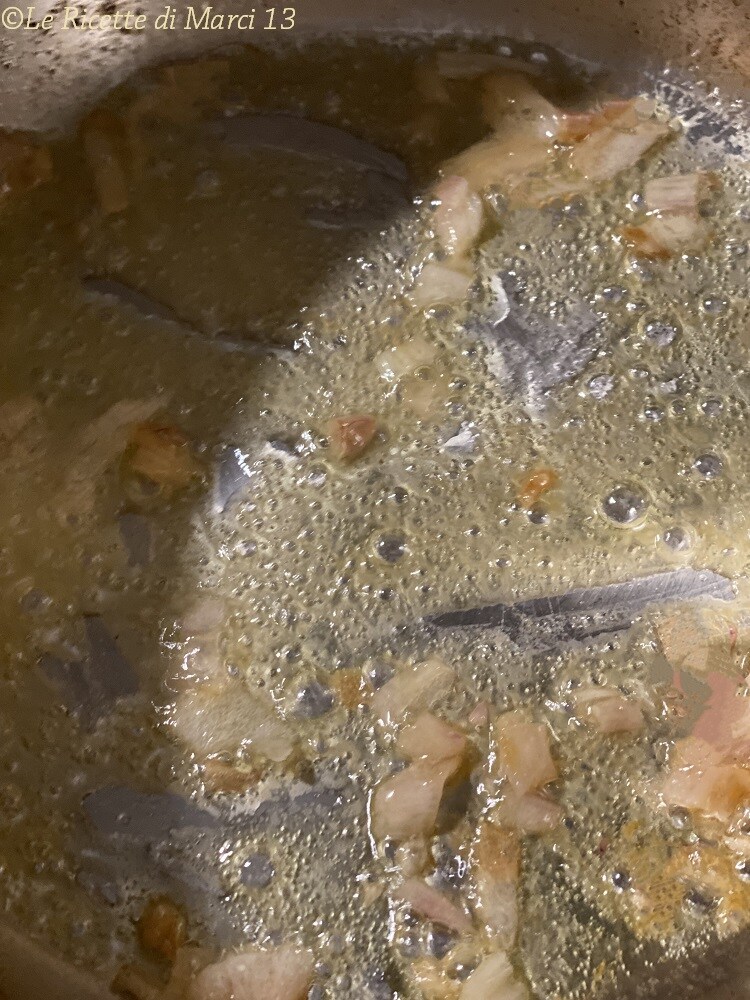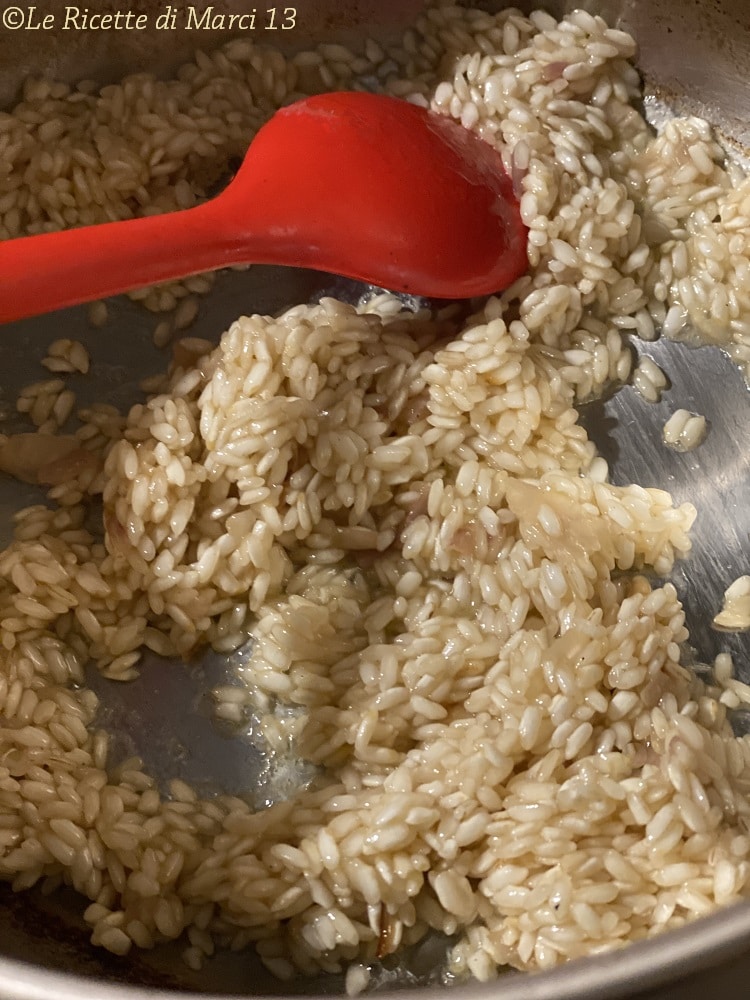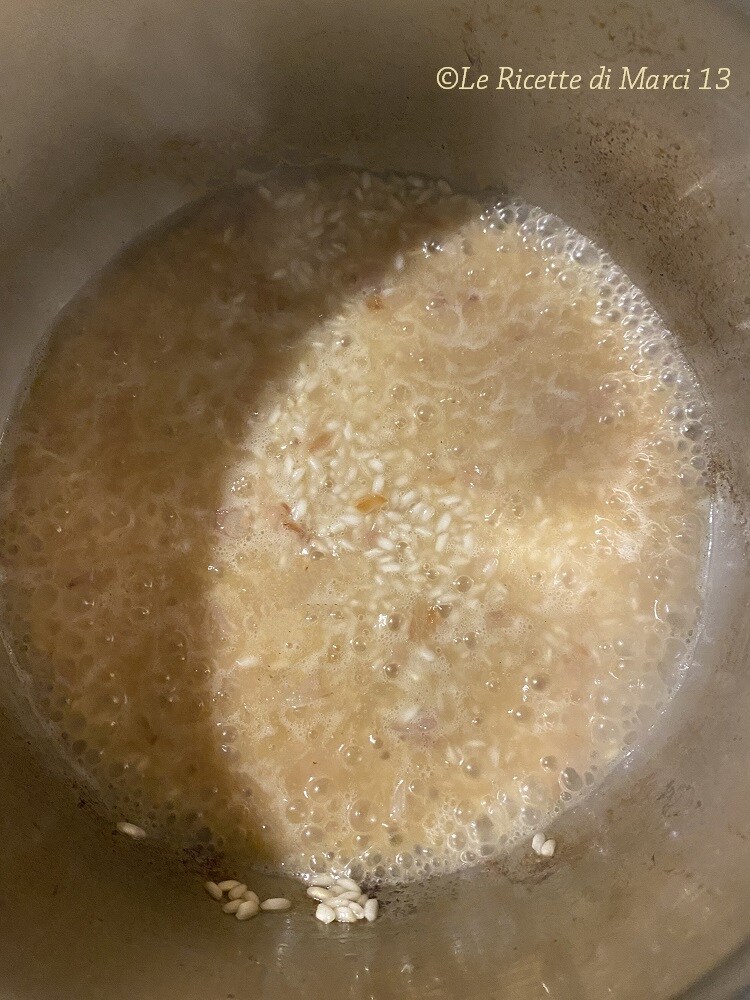Creamy Gorgonzola Risotto with Pears and Walnuts. Exquisite and refined main course
As the famous proverb goes: “Don’t let the farmer know how good cheese is with pears,” that’s why this risotto is particularly tasty! The spicy savoriness of the Gorgonzola perfectly matches the sweetness of the pears, adding creaminess to the risotto along with a proper touch of crunchiness, given by the walnuts.
In this recipe, I will also reveal all the secrets for a perfect wave risotto.
A versatile main course that can be served for Sunday lunch or an elegant and refined winter dinner.
You might also be interested in:

- Difficulty: Very easy
- Cost: Affordable
- Rest time: 2 Minutes
- Preparation time: 10 Minutes
- Portions: 3 people
- Cooking methods: Stovetop
- Cuisine: Italian
- Seasonality: Autumn, Winter
Ingredients for Creamy Gorgonzola Risotto with Pears and Walnuts
- 1.5 cups Carnaroli rice
- 3.5 oz Gorgonzola cheese (spicy)
- 2 Decana pears (or Kaiser, about 12 oz)
- 3.5 oz walnut kernels (chopped)
- 5 cups vegetable broth (or stock cube)
- 2 shallots
- 3.5 oz butter (high quality)
- 0.5 cup dry white wine
- 3.5 oz Parmigiano Reggiano DOP (grated, optional)
- fine salt (a little, to check if you used the stock cube)
Tools for Creamy Gorgonzola Risotto with Pears and Walnuts
- Bowl
- Cutting board
- Knife
- Hand whisk
- Le Creuset Risotto Pan
- Pot stainless steel with a thick bottom, 22 cm in diameter
Steps for Creamy Gorgonzola Risotto with Pears and Walnuts
Wash and peel the pears, then dice them.
Remove the rind from the Gorgonzola and cut it into cubes.
Coarsely chop the walnut kernels.
Heat the vegetable broth (made at home (see notes below) or with a stock cube). It should be boiling.
Finely chop the two shallots and gently sauté them in a stainless steel pan (or cast iron or aluminum) with a thick bottom, along with 2 tbsp of butter (reserve the remaining 1 tbsp for the final mantecare).

Then add the rice and toast it for about 3 minutes (it should become translucent and mother-of-pearl-like) over high heat, stirring constantly.
Once the toasting is complete, deglaze by raising the flame and pouring, gradually, the ice-cold dry white wine very cold (Gewurztraminer Alto Adige, is perfect for this Gorgonzola risotto). It is important to raise the flame when pouring the cold wine to create the thermal shock that allows the grains to release the starch.

When the alcohol has completely evaporated (it will take about 5 minutes), gradually add a ladle of hot vegetable broth at a time, only when the broth has been completely absorbed, add another ladle (NOT all at once). Continue in this way, the rice grains should be covered just to the surface by the broth, with additions of a ladle at a time and only when the previously added one has been completely absorbed until the rice is cooked (it will take about 15 minutes from when the first ladle of broth is added). Some suggest using a hand whisk to stir the rice while cooking with the broth, in this way, the starch released by the rice grains will whip up easily, resulting in a creamier risotto. NEVER add cold broth, as it stops the cooking of the risotto.

5 minutes before the end of cooking, add the diced pears (actually, I prefer to add the pears earlier when I start pouring the broth) and the spicy Gorgonzola, mixing well. Adjust the salt.

Then turn off the heat and add the grated Parmigiano (optional) and the remaining 2 tbsp of cold butter, mixing well off the heat. For a perfect mantecare, let the risotto rest for 2 minutes, removing it from the heat and covering it with a lid, allowing the flavors to blend well. After resting, stir again and finally apply the wave technique (optional): shake the pan with quick and regular movements back and forth, so that the risotto folds into a wave. It is important to know that the faster the movements are, the more the rice releases starch and the more creamy the risotto becomes. Then complete the risotto by garnishing it with chopped walnuts and thin slices of pear.
Notes and Tips for Creamy Gorgonzola Risotto with Pears and Walnuts
If you don’t like spicy Gorgonzola and prefer a milder flavor, you can replace the spicy Gorgonzola with sweet Gorgonzola and also add 2 tablespoons of mascarpone or cooking cream. Or if you simply don’t like Gorgonzola, you can use Taleggio, Fontina, or Brie instead.
If you don’t like spicy Gorgonzola and prefer a milder flavor, you can replace the spicy Gorgonzola with sweet Gorgonzola and also add 2 tablespoons of mascarpone or cooking cream. Or if you simply don’t like Gorgonzola, you can use Taleggio, Fontina, or Brie instead.
How to make homemade vegetable broth: Fill a pot with 5 cups of cold water, add 2 onions, 2 carrots, and 1 celery stalk cut into pieces, place on the stove, and let it simmer over very low heat for about twenty minutes. When preparing the broth, the ratio is approximately 1.3 cups for every 3 oz of rice.
How to make homemade vegetable broth: Fill a pot with 5 cups of cold water, add 2 onions, 2 carrots, and 1 celery stalk cut into pieces, place on the stove, and let it simmer over very low heat for about twenty minutes. When preparing the broth, the ratio is approximately 1.3 cups for every 3 oz of rice.
FAQ
What is Risotto?
The term risotto refers to a dish with a creamy texture, where each individual grain of rice is bound by a sauce made from the starch they released during cooking and the melted butter and cheese added at the end. Although it belongs to the culinary tradition of Northern Italy, risotto is popular in Italian cuisine throughout Italy and abroad. The rice must be strictly one of these varieties: Carnaroli, Arborio, or Vialone Nano; however, Carnaroli is the best as it does not overcook easily and keeps the grains well-separated and not sticky, possessing a high starch content that gives the risotto its creaminess. The quantity is calculated between 2.5 to 3 oz per person (for further details, see here).
Why toast the rice for risotto?
Toasting serves to seal the outer walls of the grains to prevent them from breaking down during cooking, making the risotto too soft and sticky. Toasting the rice is how we make a true risotto and not just boiled rice.
How is risotto mantecare done?
Mantecare is done strictly off the heat. Mantecare refers to the process, at the end of cooking, whereby the rice is blended with cheese and cold butter, off the heat to achieve a well-bound and creamy risotto and to create the wave effect. Using cold butter increases the contrast with the hot risotto, creating a cream that makes it perfect.
For a perfect mantecare, let the risotto rest for 2 minutes, removing it from the heat and covering it with a lid. For perfectly mantecareing the risotto, use aged cheese like Grana Padano or Parmigiano Reggiano.Which pot should be used for a perfect risotto?
A quality pot (cast iron, stainless steel, aluminum) with a heavy bottom to prevent sticking or burning, preferably with a good long handle (useful during mantecare).
When should salt be added to the risotto?
1) If you’re using homemade vegetable broth, the salt is added while toasting the rice grains, so they get perfectly salted right away. If added later (while cooking with the broth), you’re just salting the broth (unnecessarily).
2) If using a stock cube (already salted), taste mid-way through rice cooking to decide whether to add more salt.What is the difference between wave risotto and mantecare?
None! Mantecare is one of the stages of preparing wave risotto; essentially, it can be asserted that without a properly executed mantecare it is impossible to achieve a perfect wave risotto. After mantecare, the risotto rests, covered, for 2 minutes, followed by the wave technique: shake the pan with quick and regular back and forth movements, so that the risotto folds into a wave. Finally, it’s important to know that the faster the movements, the more your risotto releases starch and forms that pleasant creamy texture. The risotto is wave if, when tilting the plate, it follows the inclination gently.

